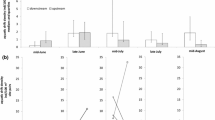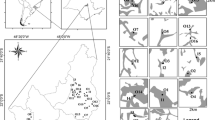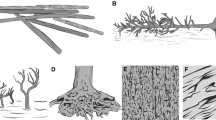Abstract
Intensive forestry and other activities that alter riparian vegetation may disrupt the connectivity and the flux of energy between terrestrial and aquatic habitats and have large effects on biota, especially in small streams. We manipulated the amount of in-stream wood and the flux of terrestrial invertebrate subsidies to determine how these factors affected potential food resources for drift-feeding brown trout (Salmo trutta ) in a boreal Swedish forest stream. Specifically, we followed the effects on the abundance of aquatic and terrestrial invertebrate fauna from June to August 2007. The treatments were 1) addition of wood, unmanipulated terrestrial invertebrate inputs, 2) reduction of terrestrial invertebrate inputs (using canopy covers), no addition of wood, 3) unmanipulated ambient conditions, 4) simultaneous addition of wood and reduction of terrestrial invertebrate inputs. Added wood resulted in greater biomass of aquatic invertebrate biomass, and both input and drift of terrestrial invertebrates were reduced by canopy covers. In terms of total potential prey biomass, the addition of wood with ambient levels of terrestrial invertebrate inputs had the highest standing crop of benthic, wood-living and terrestrial invertebrates combined, whereas the treatment with reduced terrestrial input and no wood added had the lowest standing crop. Our study indicates that forest practices that both reduce the recruitment of wood and the input of terrestrial invertebrates to small streams have negative effects on prey availability for drift-feeding brown trout. The positive effects of wood addition on biomass of aquatic macroinvertebrates may partly compensate for the negative effects of reduced terrestrial invertebrate subsidies.







Similar content being viewed by others
References
Allan JD, Wipfli MS, Caouette JP, Prussian A, Rodgers J (2003) Influence of streamside vegetation on inputs of terrestrial invertebrates to salmonid food webs. Can J Fish Aquat Sci 60:309–320
Allen KR (1951) The Horowiki stream: a study of a trout population. NZ Mar Dep Fish Bull 10:1–238
Angermeir PL, Karr JR (1983) Fish communities along environmental gradients in a system of tropical streams. Environ Biol Fish 9:117–135
Baxter CV, Fausch KD, Saunders WC (2005) Tangled webs: reciprocal flows of invertebrate prey link streams and riparian zones. Freshw Biol 50:201–220
Benke AC, Wallace JB (2003) Influence of Wood on Invertebrate Communities in Streams and Rivers. Am Fish Soc Symp 37:149–177
Benke AC, Van Arsdall TC, Jr GDM, Parrish FK (1984) Invertebrate productivity in a subtropical blackwater river: the importance of habitat and life history. Ecol Monogr 54:25–63
Bilby RE, Likens GE (1980) Importance of organic debris dams in the structure and function of stream eco-systems. Ecology 61:1107–1113
Bilby RE, Ward JW (1991) Characteristics and function of large woody debris in streams draining old-growth, clear-cut and second-growth forests in southwestern Washington. Can J Fish Aquat Sci 48:2499–2508
Bisson PA, Bilby RE, Bryant MD, Dolloff CA, Grette GB, House RA, Murphy M, Koski V, Sedell JR (1987) Large Woody Debris in forested streams in the Pacific Northwest: past, present and future. In: Salo EO, Cundy TW (eds) Streamside Management: Forestry and Fisheries interactions. Contribution No. 57, Institute of Forest Resources, University of Washington, pp 143–190
Bond NR, Sabater S, Glaister A, Roberts S, Vanderkruk K (2006) Colonisation of introduced timber by algae and invertebrates, and its potential role in aquatic ecosystem restoration. Hydrobiologia 556:303–316
Bridcut EE (2000) A study of terrestrial and aerial macroinvertebrates on river banks and their contribution to drifting fauna and Salmonid diets in a Scottish catchment. Hydrobiologia 427:83–100
Bridcut EE, Giller PS (1995) Diet variability and foraging strategies in brown trout (Salmo trutta): an analysis from subpopulations to individuals. Can J Fish Aquat Sci 52:2543–2552
Cloe WW, Garman GC (1996) The energetic importance of terrestrial arthropod inputs to three warm-water streams. Freshw Biol 36:105–115
Cummins KW, Wuycheck JC (1971) Caloric equivalents for investigations in ecological energetics. Verh Int Ver Theor Angew Limnol 18:1–158
Dahlström N (2005) Function and dynamics of woody debris in boreal forest streams. Dissertation. Umeå University, Sweden
Dineen G, Harrison SSC, Giller PS (2007) Diet partitioning in sympatric Atlantic salmon and brown trout in streams with contrasting riparian vegetation. J Fish Biol 71:17–38
Dolloff CA (1986) Effects of stream cleaning on juvenile coho salmon and Dolly Varden in southeast Alaska. Trans Am Fish Soc 115:743–755
Drury DM, Kelso WE (2000) Invertebrate colonization of woody debris in coastal plain streams. Hydrobiologia 434:63–72
Dunbrack RL, Dill LM (1983) A model of size dependent surface feeding in a stream dwelling Salmonid. Environ Biol Fish 8:203–216
Edwards ED, Huryn AD (1995) Annual contribution of terrestrial invertebrates to a New Zealand stream. NZ J Mar Freshw Res 29:467–477
Edwards ED, Huryn AD (1996) Effect of riparian land use on contributions of terrestrial invertebrates to streams. Hydrobiologia 337:151–159
Elliott JM (1994) Quantitative ecology and the brown trout. Oxford University press
Englund G, Olsson T (1996) Treatment effects in a stream fish enclosure experiment: influence of predation rate and prey movements. Oikos 77:519–527
Fausch KD, Northcote TG (1992) Large Woody Debris and Salmonid Habitat in a Small Coastal British-Columbia Stream. Can J Fish Aquat Sci 49:682–693
Greenberg L, Dahl J, Bergman E (2005) Indirect behavioral effects of a piscivore on trophic interactions in stream enclosures. Arch Hydrobiol 164:39–51
Gustafsson P (2011) Forest-stream linkages. Brown trout (Salmo trutta) responses to woody debris, terrestrial invertebrates and light. Dissertation. Karlstad University, Sweden
Hax CL, Golladay SW (1993) Macroinvertebrate colonization and biofilm development on leaves and wood in a boreal river. Freshw Biol 29:79–87
Hayes JW, Stark JD, Shearer KA (2000) Development and test of a whole-lifetime foraging and bioenergetics model for drift-feeding brown trout. Trans Am Fish Soc 129:315–332
Hayes JW, Hughes NF, Kelly LH (2007) Process-based modeling of invertebrate drift transport, net energy intake and reach carrying capacity for drift-feeding salmonids. Ecol model 207:171–188
Hernandez O, Merritt RW, Wipfli MS (2005) Benthic invertebrate community structure is influenced by forest succession after clearcut logging in southeastern Alaska. Hydrobiologia 533:45–59
Hilderbrand RH, Lemly AD, Dolloff CA, Harpster KL (1997) Effects of large woody debris placement on stream channels and benthic macroinvertebrates. Can J Fish Aquat Sci 54:931–939
Hill WR, Mulholland PJ, Marzolf ER (2001) Stream ecosystem responses to forest leaf emergence in spring. Ecology 82:2306–2319
Hunt RL (1975) Use of terrestrial invertebrates as food by salmonids. In: Hasler AD (ed) Coupling of Land and Water systems. Springer Verlag, New York, pp 137–152
Hunter AF (1991) Traits that distinguish outbreaking and nonout-breaking macrolepidoptera feeding on northern hardwood trees. Oikos 60:275–282
Hyatt TL, Naiman RJ (2001) The residence time of large woody debris in the Queets River, Washington, USA. Ecol Appl 11:191–202
Hynes HBN (1970) The ecology of running waters. University of Toronto Press, Toronto
Johnson LB, Breneman DB, Richards C (2003) Macroinvertebrate community structure and function associated with large wood in low gradient streams. River Res Appl 19:199–218
Jones BCJ, Despland E (2006) Effects of synchronization with host plant phenology occur early in the larval development of a spring folivore. Can J Zool 84:628–633
Kawaguchi Y, Nakano S (2001) Contribution of terrestrial invertebrates to the annual resource budget for salmonids in forest and grassland reaches of a headwater stream. Freshw Biol 46:303–316
Kawaguchi Y, Taniguchi Y, Nakano S (2003) Terrestrial invertebrate inputs determine the local abundance of stream fishes in a forested stream. Ecology 84:701–708
Keim RF, Skaugset AE, Bateman DS (2002) Physical Aquatic Habitat II. Pools and Cover Affected by Large Woody Debris in Three Western Oregon Streams. North Am J Fish Manage 22:151–164
Keller EA, Swanson FJ (1979) Effects of large organic material on channel form and fluvial processes. Earth Surf Process Landf 4:361–380
Lehane BM, Giller PS, O’Halloran J, Smith C, Murphy J (2002) Experimental provision of large woody debris in streams as a trout management technique. Aquatic conserv: Mar Freshw Ecosyst 12:289–311
Lisle TE (1986) Effects of Woody Debris on Anadromous Salmonid habitat, Prince of Wales Island, Southeast Alaska. North Am J Fish Manage 6:538–550
Mason CF, MacDonald SM (1982) The input of terrestrial invertebrates from tree canopies to a stream. Freshw Biol 12:305–311
Nakano S, Murakami M (2001) Reciprocal subsidies: dynamic interdependence between terrestrial and aquatic food webs. Proc Natl Acad Sci USA 98:166–170
Nakano S, Miyasaka H, Kuhara N (1999) Terrestrial-aquatic linkages: riparian arthropod inputs alter trophic cascades in a stream food web. Ecology 80:2435–2441
O’Connor NA (1991) The effects of habitat complexity on the macroinvertebrate colonizing wood substrates in lowland stream. Oecologia 85:504–512
O’Connor NA (1992) Quantification of submerged wood in a lowland Australian stream system. Freshw Biol 27:387–395
Richmond AD, Fausch KD (1995) Characteristics and function of large woody debris in subalpine Rocky Mountain streams in northern Colorado. Can J Fish Aquat Sci 52:1789–1802
Roberts S, Sabater S, Beardall J (2004) Benthic micro algal colonization in streams of differing riparian cover and light availability. J Phycol 40:1004–1012
Romaniszyn ED, Hutchens JJ, Wallace JB (2007) Aquatic and terrestrial invertebrate drift in southern Appalachian Mountain streams: implications for trout food resources. Freshw Biol 52:1–11
Roni P, Quinn TP (2001) Density and size of juvenile salmonids in response to placement of large woody debris in western Oregon and Washington streams. Can J Fish Aquat Sci 58:282–292
Spänhoff B, Alecke C, Meyer EI (2000) Colonization of submerged twigs and branches of different wood genera by aquatic macroinvertebrates. Internat Rev Hydrobiol 85:49–66
Speaker RW, Moore K, Gregory S (1984) Analysis of the process of retention of organic matter in stream ecosystems. Verh Internat Verein Limnol 22:1835–1841
Sundbaum K, Näslund I (1998) Effects of woody debris on the growth and behaviour of brown trout in experimental stream channels. Can J Zool 76:56–61
Urabe H, Nakano S (1998) Contribution of woody debris to trout habitat modification in small streams in secondary deciduous forest, northern Japan. Ecol Res 13:335–345
Vannote RL, Minshall GW, Cummins KW, Sedell JR, Cushing CE (1980) The river continuum concept. Can J Fish Aquat Sci 37:130–137
Wallace JB, Benke AC (1984) Quantification of wood habitat in subtropical coastal plain streams. Can J Fish Aquat Sci 41:1643–1652
Webster JJ, Hartman KJ (2005) The role of terrestrial invertebrates in allopatric brook trout headwater streams in the central Appalachian mountains. J Freshwater Ecol 20:101–107
Wipfli MS (1997) Terrestrial invertebrates as salmonid prey and nitrogen sources in streams: contrasting old-growth and young-growth riparian forests in southeastern Alaska, U.S.A. Can J Fish Aquat Sci 54:1259–1269
Zadorina VM (1988) Importance of adult insects in the diet of young trout and salmon. Voprosy Ikhtiology 2:259–265
Zimmerman JHK, Vondracek B (2006) Effects of stream enclosures on drifting invertebrates and fish growth. J N Am Benthol Soc 25:453–464
Acknowledgements
We would like to express our genuine appreciation for the help we received by Tomas Axelsson, Oskar Calson and David Zetterqvist, both in the field and laboratory. Much appreciation also goes to the local fishery board of Lake Övre Gla and their chairman, Mats Gustafsson, for making the stream available and for vital support in many practical matters. Certificate number from the Swedish ethical board of animal welfare: 99–2007.
Author information
Authors and Affiliations
Corresponding author
Rights and permissions
About this article
Cite this article
Gustafsson, P., Greenberg, L.A. & Bergman, E. Woody debris and terrestrial invertebrates – effects on prey resources for brown trout (Salmo trutta) in a boreal stream. Environ Biol Fish 97, 529–542 (2014). https://doi.org/10.1007/s10641-014-0250-y
Received:
Accepted:
Published:
Issue Date:
DOI: https://doi.org/10.1007/s10641-014-0250-y




